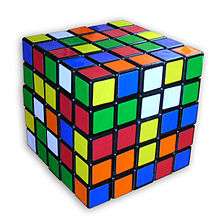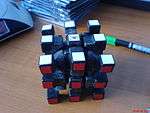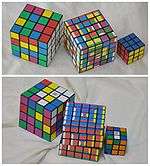Professor's Cube
The Professor's Cube is a combination puzzle, a 5×5×5 version of the Rubik's Cube. It has qualities in common with both the original 3×3×3 Rubik's Cube and the 4×4×4 Rubik's Revenge, and knowing how to solve either can help when working on the 5×5×5 cube.

History
origArxon_Wiki.jpg)

The 5×5×5 cube was created by Udo Krell in 1981. Out of many designs that were proposed, Udo Krell's design was the first 5×5×5 design that was manufactured and sold. Uwe Mèffert manufactured the cube and sold it in Hong Kong in 1983.
Ideal Toys marketed the 5x5x5 cube in Germany as the "Rubik's Wahn" (Wahn meaning delusion or illusion). The 5×5×5 cube got its name when the cube was marketed in Japan under the name "Professor's Cube". Mèffert reissued the cube under the name "Professor's Cube" in the 1990s. [1]
Early versions of the 5×5×5 cube sold at Barnes & Noble were marketed under the name "Professor's Cube" but currently, Barnes and Noble sells cubes that are simply called "5×5." Mefferts.com offers a limited edition version of the 5×5×5 cube called the Professor's Cube. This version has colored tiles rather than stickers.[2] Verdes Innovations sells a version called the V-Cube 5.[3]
Workings


The original Professor's Cube design by Udo Krell works by using an expanded 3×3×3 cube as a mantle with the center edge pieces and corners sticking out from the spherical center of identical mechanism to the 3×3×3 cube. All non-central pieces have extensions that fit into slots on the outer pieces of the 3×3×3, which keeps them from falling out of the cube while making a turn. The fixed centers have two sections (one visible, one hidden) which can turn independently. This feature is unique to the original design.[4]
The Eastsheen version of the puzzle uses a different mechanism. The fixed centers hold the centers next to the central edges in place, which in turn hold the outer edges. The non-central edges hold the corners in place, and the internal sections of the corner pieces do not reach the center of the cube.[5]
The V-Cube 5 mechanism, designed by Panagiotis Verdes, has elements in common with both. The corners reach to the center of the puzzle (like the original mechanism) and the center pieces hold the central edges in place (like the Eastsheen mechanism). The middle edges and center pieces adjacent to them make up the supporting frame and these have extensions which hold the rest of the pieces together. This allows smooth and fast rotation and creating arguably the fastest and most durable version of the puzzle at that time. Unlike the original 5×5×5 design, the V-Cube 5 mechanism was designed to allow speedcubing.[6] Most current production 5×5×5 speed cubes have mechanisms based on Verdes' patent.
 A disassembled Professor's Cube
A disassembled Professor's Cube A disassembled V-Cube 5
A disassembled V-Cube 5 A disassembled Eastsheen cube
A disassembled Eastsheen cube
Durability

The original Professor's Cube is inherently more delicate than the 3×3×3 Rubik's Cube because of the much greater number of moving parts. Because of the fragile design, the Professor's Cube is not suitable for speedcubing. Applying excessive force to the cube when twisting it may result in broken pieces.[7] Both the Eastsheen 5×5×5 and the V-Cube 5 are designed with different mechanisms in an attempt to remedy the fragility of the original design.
Permutations
There are 98 pieces on the exterior of the cube: 8 corners, 36 edges, and 54 centers (48 movable, 6 fixed).
Any permutation of the corners is possible, including odd permutations, giving 8! possible arrangements. Seven of the corners can be independently rotated, and the orientation of the eighth depends on the other seven, giving 37 (or 2,187) combinations.
There are 54 centers. Six of these (the center square of each face) are fixed in position. The rest consist of two sets of 24 centers. Within each set there are four centers of each color. Each set can be arranged in 24! different ways. Assuming that the four centers of each color in each set are indistinguishable, the number of permutations of each set is reduced to 24!/(246) arrangements, all of which are possible. The reducing factor comes about because there are 24 (4!) ways to arrange the four pieces of a given color. This is raised to the sixth power because there are six colors. The total number of permutations of all movable centers is the product of the permutations of the two sets, 24!2/(2412).
The 24 outer edges cannot be flipped, since the interior shape of those pieces is asymmetrical. Corresponding outer edges are distinguishable, since the pieces are mirror images of each other. Any permutation of the outer edges is possible, including odd permutations, giving 24! arrangements. The 12 central edges can be flipped. Eleven can be flipped and arranged independently, giving 12!/2 × 211 or 12! × 210 possibilities (an odd permutation of the corners implies an odd permutation of the central edges, and vice versa, thus the division by 2). There are 24! × 12! × 210 possibilities for the inner and outer edges together.
This gives a total number of permutations of
The full number is precisely 282 870 942 277 741 856 536 180 333 107 150 328 293 127 731 985 672 134 721 536 000 000 000 000 000 possible permutations[8] (about 283 duodecillion on the long scale or 283 tresvigintillion on the short scale).
Some variations of the Professor's Cube have one of the center pieces marked with a logo, which can be put into four different orientations. This increases the number of permutations by a factor of four to 1.13×1075, although any orientation of this piece could be regarded as correct. By comparison, the number of atoms in the observable universe is estimated at about 1080. Other variations increase the difficulty by making the orientation of all center pieces visible. An example of this is shown below.
Solution


Speedcubers usually favour the reduction method of grouping similar edge pieces into solid strips, and centers into one-colored blocks. This allows the cube to be quickly solved with the same methods one would use for a 3×3×3 cube. As illustrated to the right, the fixed centers, middle edges and corners can be treated as equivalent to a 3×3×3 cube. As a result, once reduction is complete the parity errors sometimes seen on the 4×4×4 cannot occur on the 5×5×5, or any cube with an odd number of edges for that matter.[9]
Yau5 is another method speedcubers use. It is named after its proposer, Robert Yau. The method starts by solving the opposite centers, then solving three cross edges. Next, the remaining centers and last cross edge are solved. Any remaining unsolved edges are solved, and can be solved like a 3x3x3.[10]
Another frequently used strategy is to solve the edges and corners of the cube first, and the centers last. This method is referred to as the Cage method, so called because the centers appear to be in a cage after the solving of edges and corners. The corners can be placed just as they are in any previous order of cube puzzle, and the centers are manipulated with an algorithm similar to the one used in the 4×4×4 cube.[11]
A less frequently used strategy is to solve one side and one rim first, then the 2nd, 3rd and 4th rim, and finally the last side and rim. That is, like building a building. First the basement, then each floor, and finally the roof.[12]
World records
The world record fastest 5×5×5 solve is 34.92 seconds, set by Max Park of the United States on 25 January, 2020 at Houston Winter 2020, in Houston, Texas.[13]
The world record for average of five solves (excluding fastest and slowest) is 39.65 seconds, also set by Max Park on 22 June, 2019 at CubingUSA Western Championship 2019 in Los Angeles, California, with the times of 40.34, (36.06), (42.65), 40.82, and 37.80 seconds.[13]
The record fastest time for solving a 5×5×5 cube blindfolded is 2 minutes, 21.62 seconds (including inspection), set by Stanley Chapel of the United States on 15 December 2019 at Michigan Cubing Club Epsilon 2019 in Ann Arbor, Michigan, Michigan.[14]
The record for mean of three solves solving a 5x5x5 cube blindfolded is 2 minutes, 27.63 seconds (including inspection), also set by Stanley Chapel of the United States on 15 December 2019 with the times of 2:32.48, 2:28.80 and 2:21.62[14]
Top 5 solvers by single solve[15]
| Name | Fastest solve | Competition |
|---|---|---|
| Max Park | 34.92s | Houston Winter 2020 |
| Feliks Zemdegs | 37.93s | Canberra Autumn 2018 |
| Ciarán Beahan | 38.96s | WCA World Championship 2019 |
| Patrick Ponce | 40.43s | WCA World Championship 2019 |
| Seung Hyuk Nahm (남승혁) | 40.66s | WCA World Championship 2019 |
Top 5 solvers by average of 5 solves[16]
| Name | Fastest average | Competition |
|---|---|---|
| Max Park | 39.65s | CubingUSA Western Championship 2019 |
| Feliks Zemdegs | 42.09s | Melbourne Summer 2020 |
| Seung Hyuk Nahm (남승혁) | 44.78s | WCA World Championship 2019 |
| Bill Wang | 44.85s | Battle of Waterloo 2019 |
| Ciarán Beahan | 45.19s | Leeds Open 2019 |
In popular culture
A Filipino TV series from ABS-CBN Entertainment named Little Big Shots shows a 10-year old cuber named Franco, who solved a Professor's Cube in 1:47.12 minutes
See also
- Pocket Cube – A 2×2×2 version of the puzzle
- Rubik's Cube – The 3×3×3 original version of this puzzle
- Rubik's Revenge – A 4×4×4 version of the puzzle
- V-Cube 6 - A 6×6×6 version of the puzzle
- V-Cube 7 - A 7×7×7 version of the puzzle
- V-Cube 8 - An 8×8×8 version of the puzzle
- Combination puzzles
References
- "5x5x5 Wiki". Speedsolving.com.
- Meffert's Professor's Cube
- Verdes' Innovations V-Cube 5 page Archived 2010-03-27 at the Wayback Machine
- United States Patent 4600199
- United States Patent 6129356
- United States Patent 20070057455
- Rubik's 5×5×5 Cube notice section
- Cubic Circular Issues 3 & 4 David Singmaster, 1982
- "Reduction Method - Speedsolving.com Wiki". www.speedsolving.com. Retrieved 2020-05-21.
- "Yau5 method - Speedsolving.com Wiki". www.speedsolving.com. Retrieved 2020-05-21.
- "Cage Method - Speedsolving.com Wiki". www.speedsolving.com. Retrieved 2020-05-21.
- "Rubiks-Cube.org". Archived from the original on 2017-05-27. Retrieved 2020-05-11.
- World Cube Association Official Results - 5x5x5 Cube
- World Cube Association Official Results - 5x5x5 Blindfolded
- World Cube Association Official 5x5x5 Ranking Single
- World Cube Association Official 5x5x5 Ranking Average
